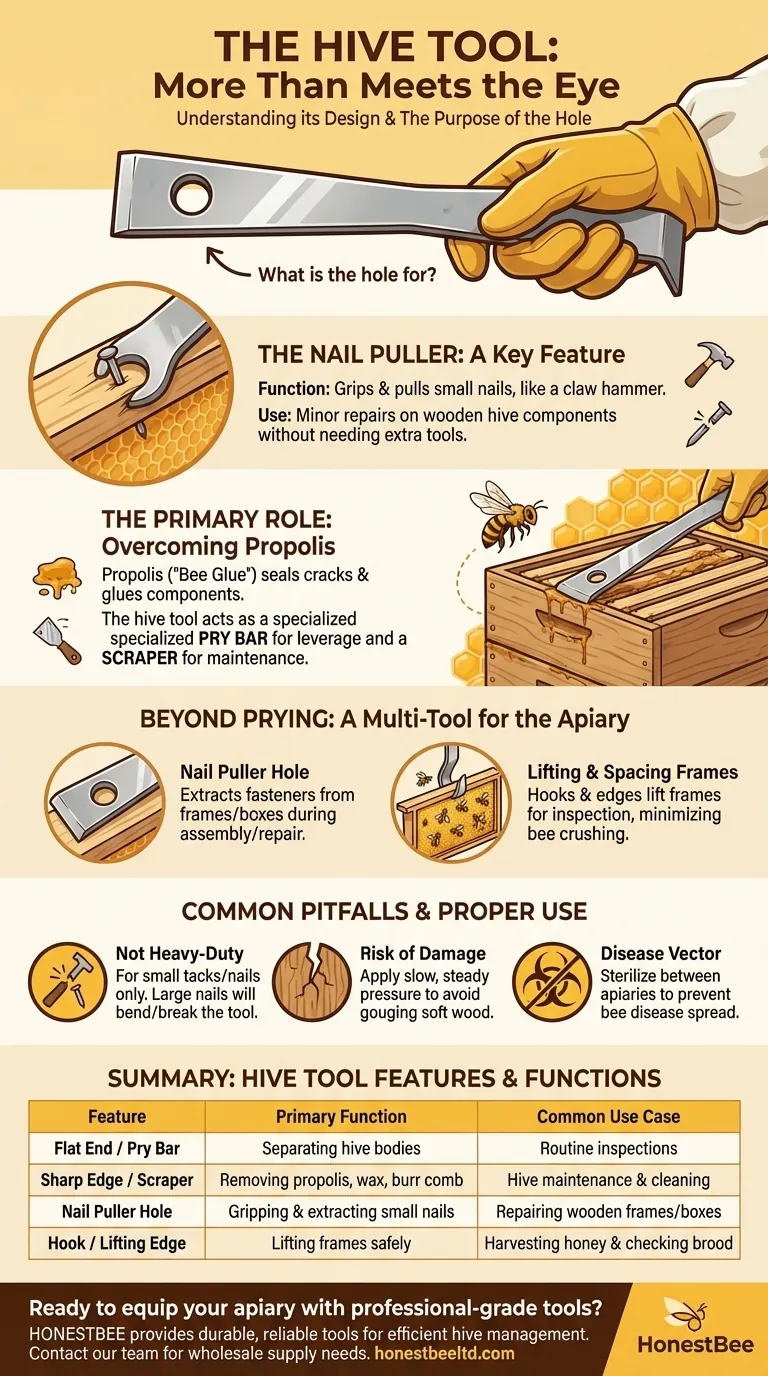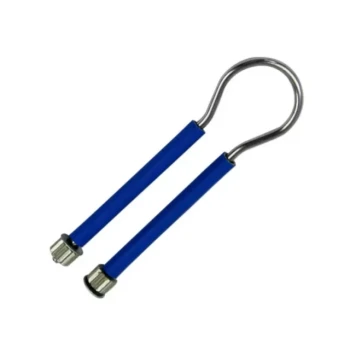The small hole in a standard hive tool has a simple, specific function. It is designed to grip and pull out small nails, working much like the claw of a hammer. This feature allows a beekeeper to perform minor repairs on wooden hive components, such as frames and boxes, without needing to retrieve a separate tool.
While often overlooked, the hive tool's nail-pulling hole is a key feature that transforms it from a simple pry bar into a versatile multi-tool. Its existence underscores the tool's fundamental purpose: to solve any physical problem a beekeeper encounters while working in the apiary.

The Hive Tool's Primary Role: Overcoming Propolis
To understand the hive tool's design, you first have to understand the substance it was created to defeat: propolis.
What is Propolis?
Honeybees produce propolis, a sticky, resin-like substance, from tree sap and other botanical sources. They use this "bee glue" to seal small cracks, reinforce the hive structure, and glue every component together for stability.
The Essential Pry Bar
Because of propolis, hive bodies, supers, and frames can become cemented together. The primary function of a hive tool is to act as a specialized pry bar, giving the beekeeper the leverage needed to safely separate these components for inspection.
The Indispensable Scraper
The tool's sharpened, flat edge is also crucial for hive maintenance. It is used to scrape away unwanted propolis, excess beeswax, and burr comb from frames and hive boxes, ensuring parts fit together correctly and frames remain easy to remove.
Beyond Prying: A Multi-Tool for the Apiary
While prying and scraping are its main jobs, the hive tool incorporates other features that make it an indispensable instrument for any hive-side task.
The Nail Puller Explained
The hole or notch is specifically shaped to catch the head of a small nail or tack. A beekeeper can use the tool's leverage to easily extract fasteners from wooden frames or hive bodies during assembly or repair.
Lifting and Spacing Frames
The various hooks and edges of a hive tool are designed to lift frames for inspection. This allows a beekeeper to carefully grip the top of a frame and pull it straight up, minimizing the risk of rolling or crushing bees.
Common Pitfalls and Proper Use
A hive tool is robust, but using it correctly is key to protecting your equipment and your bees.
Not a Heavy-Duty Tool
The nail puller is designed for the small tacks and nails typically used in beekeeping equipment. Attempting to pull large construction nails will likely bend or break the tool.
Risk of Damaging Equipment
It is a pry bar, and applying force incorrectly can easily gouge and damage the soft wood of your hive boxes and frames. Always apply slow, steady pressure to gently break the propolis seal.
A Potential Vector for Disease
Hive tools come into direct contact with all internal parts of the hive. It is critical to clean and sterilize your tool, especially when moving between different apiaries, to prevent the spread of bee diseases.
Making the Right Choice for Your Goal
Your approach to using the tool should align with the specific task at hand.
- If your primary focus is routine inspection: Rely on the flat end to pry apart hive bodies and the sharp edge to scrape propolis from the frame rests.
- If your primary focus is repairing woodenware: Utilize the nail-pulling hole to efficiently remove small nails from frames and boxes before making adjustments.
- If your primary focus is harvesting honey: Depend on the tool to gently pry frames loose from the super, minimizing disruption to the hive structure.
Mastering this simple, versatile device is a fundamental step toward becoming a confident and efficient beekeeper.
Summary Table:
| Hive Tool Feature | Primary Function | Common Use Case |
|---|---|---|
| Flat End / Pry Bar | Separating hive bodies glued with propolis. | Routine hive inspections. |
| Sharp Edge / Scraper | Removing excess propolis, wax, and burr comb. | Hive maintenance and cleaning. |
| Nail Puller Hole | Gripping and extracting small nails or tacks. | Repairing wooden frames and hive boxes. |
| Hook / Lifting Edge | Lifting frames for inspection without crushing bees. | Harvesting honey and checking brood. |
Ready to equip your apiary with professional-grade tools?
As a trusted wholesale supplier for commercial apiaries and beekeeping equipment distributors, HONESTBEE provides the durable, reliable tools you need for efficient hive management. Our hive tools are built to withstand daily use, helping you and your customers perform inspections, maintenance, and repairs with confidence.
Let's discuss your supply needs. Contact our team today to explore our full catalog of beekeeping supplies and equipment.
Visual Guide

Related Products
- HONESTBEE Advanced Ergonomic Stainless Steel Hive Tool for Beekeeping
- HONESTBEE Professional Long Handled Hive Tool with Precision Cutting Blade
- HONESTBEE Premium Italian Style Hive Tool with Hardwood Handle
- HONESTBEE Professional Multi-Functional Hive Tool with Ergonomic Wood Handle
- Professional Dual-End Stainless Steel Hive Tool for Beekeeping
People Also Ask
- How should beekeepers handle bees when using a hive tool? Master Calm, Deliberate Techniques
- Why is it important to compare the progress of different hives? A Beekeeper's Key Diagnostic Tool
- How is a hive tool used for scraping and cleaning? Master Hive Maintenance for a Healthy Colony
- What tools are used for cleaning frames? A Beekeeper's Simple 4-Tool Guide
- What are the features of a regular hive tool? The Essential Multi-Tool for Every Beekeeper



















